Vue2 源码从零详解系列文章, 还没有看过的同学可能需要看一下之前的,vue.windliang.wang/ (opens new window)
# 场景
import { observe } from "./reactive";
import { initComputed } from "./state";
import Watcher from "./watcher";
const options = {
data: {
firstName: "wind",
secondName: "liang",
title: "标题",
},
computed: {
name() {
console.log("name我执行啦!");
return this.firstName + this.secondName;
},
name2: {
get() {
console.log("name2我执行啦!");
return "name2" + this.firstName + this.secondName;
},
set() {
console.log("name2的我执行啦!set执行啦!");
},
},
},
};
observe(options.data);
initComputed(options.data, options.computed);
Vue 中肯定少不了 computed 属性的使用,computed 的最大的作用就是惰性求值,同时它也是响应式数据。
这篇文章主要就来实现上边的 initComputed 方法。
# 实现思路
主要做三件事情
- 惰性的响应式数据
- 处理
computed的值 computed属性的响应式
# 惰性的响应式数据
回想一下我们之前的 Watcher 。
如果我们调用 new Watcher
const options = {
data: {
firstName: "wind",
secondName: "liang",
},
computed: {
name() {
console.log("name我执行啦!");
return this.firstName + this.secondName;
},
},
};
observe(options.data);
new Watcher(options.data, options.computed.name);
在 Watcher 内部我们会立即执行一次 options.computed.name 并将返回的值保存起来。
export default class Watcher {
constructor(data, expOrFn, cb, options) {
this.data = data;
if (typeof expOrFn === "function") {
this.getter = expOrFn;
} else {
this.getter = parsePath(expOrFn);
}
...
this.value = this.get();
}
/**
* Evaluate the getter, and re-collect dependencies.
*/
get() {
pushTarget(this); // 保存包装了当前正在执行的函数的 Watcher
let value;
try {
value = this.getter.call(this.data, this.data);
} catch (e) {
throw e;
} finally {
// "touch" every property so they are all tracked as
// dependencies for deep watching
if (this.deep) {
traverse(value);
}
popTarget();
this.cleanupDeps();
}
return value;
}
为了实现惰性求值,我们可以增加一个 lazy 属性,构造函数里我们不去直接执行。
同时增加一个 dirty 属性,dirty 为 true 表示 Watcher 依赖的属性发生了变化,需要重新求值。dirty 为 false 表示 Watcher 依赖的属性没有发生变化,无需重新求值。
export default class Watcher {
constructor(data, expOrFn, cb, options) {
this.data = data;
if (typeof expOrFn === "function") {
this.getter = expOrFn;
} else {
this.getter = parsePath(expOrFn);
}
this.depIds = new Set(); // 拥有 has 函数可以判断是否存在某个 id
this.deps = [];
this.newDeps = []; // 记录新一次的依赖
this.newDepIds = new Set();
this.id = ++uid; // uid for batching
this.cb = cb;
// options
if (options) {
this.deep = !!options.deep;
this.sync = !!options.sync;
/******新增 *************************/
this.lazy = !!options.lazy;
/************************************/
}
/******新增 *************************/
this.dirty = this.lazy;
this.value = this.lazy ? undefined : this.get();
/************************************/
}
我们把 computed 的函数传给 Watcher 的时候可以增加一个 lazy 属性,cb 参数是为了 watch 使用,这里就传一个空函数。
const options = {
data: {
firstName: "wind",
secondName: "liang",
},
computed: {
name() {
console.log("name我执行啦!");
return this.firstName + this.secondName;
},
},
};
observe(options.data);
const noop = () => {}
const watcher = new Watcher(options.data, options.computed.name, noop, {
lazy: true,
});
console.log(watcher.value);
此时 wacher.value 就是 undefined 了,没有拿到值。
我们还需要在 Wacher 类中提供一个 evaluate 方法,供用户手动执行 Watcher 所保存的 computed 函数。
export default class Watcher {
constructor(data, expOrFn, cb, options) {
this.data = data;
if (typeof expOrFn === "function") {
this.getter = expOrFn;
} else {
this.getter = parsePath(expOrFn);
}
...
// options
if (options) {
this.deep = !!options.deep;
this.sync = !!options.sync;
this.lazy = !!options.lazy;
}
this.dirty = this.lazy;
this.value = this.lazy ? undefined : this.get();
}
/**
* Evaluate the getter, and re-collect dependencies.
*/
get() {
pushTarget(this); // 保存包装了当前正在执行的函数的 Watcher
let value;
try {
value = this.getter.call(this.data, this.data);
} catch (e) {
throw e;
} finally {
// "touch" every property so they are all tracked as
// dependencies for deep watching
if (this.deep) {
traverse(value);
}
popTarget();
this.cleanupDeps();
}
return value;
}
...
/**
* Evaluate the value of the watcher.
* This only gets called for lazy watchers.
*/
/******新增 *************************/
evaluate() {
this.value = this.get();
this.dirty = false; // dirty 为 false 表示当前值已经是最新
}
/**********************************/
}
输出 value 之前我们可以先执行一次 evaluate 。
const options = {
data: {
firstName: "wind",
secondName: "liang",
},
computed: {
name() {
console.log("name我执行啦!");
return this.firstName + this.secondName;
},
},
};
observe(options.data);
const noop = () => {};
const watcher = new Watcher(options.data, options.computed.name, noop, {
lazy: true,
});
console.log(watcher.value);
watcher.evaluate();
console.log(watcher.value);
输出结果如下:
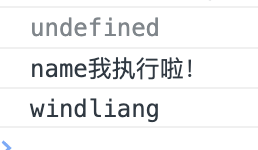
我们解决了初始时候的惰性,但如果去修改 firstName 的值,Watcher 还会立即执行,如下所示:
const options = {
data: {
firstName: "wind",
secondName: "liang",
},
computed: {
name() {
console.log("name我执行啦!");
return this.firstName + this.secondName;
},
},
};
observe(options.data);
const noop = () => {};
const watcher = new Watcher(options.data, options.computed.name, noop, {
lazy: true,
});
console.log(watcher.value);
watcher.evaluate();
console.log(watcher.value);
console.log("修改 firstName 的值");
options.data.firstName = "wind2";
setTimeout(() => {
console.log(watcher.value);
}); // 为什么用 setTimeout 参考 https://vue.windliang.wang/posts/Vue2%E5%89%A5%E4%B8%9D%E6%8A%BD%E8%8C%A7-%E5%93%8D%E5%BA%94%E5%BC%8F%E7%B3%BB%E7%BB%9F%E4%B9%8BnextTick.html
输出如下:
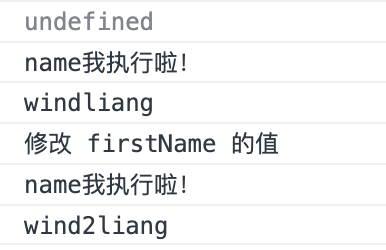
因此,当触发 Watcher 执行的时候,我们应该只将 dirty 置为 true 而不去执行。
export default class Watcher {
constructor(data, expOrFn, cb, options) {
this.data = data;
if (typeof expOrFn === "function") {
this.getter = expOrFn;
} else {
this.getter = parsePath(expOrFn);
}
...
this.dirty = this.lazy;
this.value = this.lazy ? undefined : this.get();
}
/**
* Evaluate the getter, and re-collect dependencies.
*/
get() {
pushTarget(this); // 保存包装了当前正在执行的函数的 Watcher
let value;
try {
value = this.getter.call(this.data, this.data);
} catch (e) {
throw e;
} finally {
// "touch" every property so they are all tracked as
// dependencies for deep watching
if (this.deep) {
traverse(value);
}
popTarget();
this.cleanupDeps();
}
return value;
}
/**
* Subscriber interface.
* Will be called when a dependency changes.
*/
update() {
/******新增 *************************/
if (this.lazy) {
this.dirty = true;
/************************************/
} else if (this.sync) {
this.run();
} else {
queueWatcher(this);
}
}
这样,在使用 name 值前,我们先判断下 dirty ,如果 dirty 为 true ,先手动调用 evaluate 方法进行求值,然后再使用。
const options = {
data: {
firstName: "wind",
secondName: "liang",
},
computed: {
name() {
console.log("name我执行啦!");
return this.firstName + this.secondName;
},
},
};
observe(options.data);
const noop = () => {};
const watcher = new Watcher(options.data, options.computed.name, noop, {
lazy: true,
});
console.log(watcher.value);
watcher.evaluate();
console.log(watcher.value);
console.log("修改 firstName 的值");
options.data.firstName = "wind2";
setTimeout(() => {
if (watcher.dirty) {
watcher.evaluate();
}
console.log(watcher.value);
}); // 为什么用 setTimeout 参考 https://vue.windliang.wang/posts/Vue2%E5%89%A5%E4%B8%9D%E6%8A%BD%E8%8C%A7-%E5%93%8D%E5%BA%94%E5%BC%8F%E7%B3%BB%E7%BB%9F%E4%B9%8BnextTick.html
# 处理 computed 的值
接下来就是 initComputed 的逻辑,主要就是结合上边所讲的,将传进来的 computed 转为惰性的响应式数据。
export function noop(a, b, c) {}
const computedWatcherOptions = { lazy: true };
// computed properties are just getters during SSR
export function initComputed(data, computed) {
const watchers = (data._computedWatchers = Object.create(null)); // 保存当前所有的 watcher,并且挂在 data 上供后边使用
for (const key in computed) {
const userDef = computed[key];
const getter = typeof userDef === "function" ? userDef : userDef.get; // 如果是对象就取 get 的值
// create internal watcher for the computed property.
watchers[key] = new Watcher(
data,
getter || noop,
noop,
computedWatcherOptions
);
// component-defined computed properties are already defined on the
// component prototype. We only need to define computed properties defined
// at instantiation here.
defineComputed(data, key, userDef);
}
}
上边的 defineComputed 主要就是将 computed 函数定义为 data 的属性,这样就可以像正常属性一样去使用 computed 。
const sharedPropertyDefinition = {
enumerable: true,
configurable: true,
get: noop,
set: noop,
};
export function defineComputed(target, key, userDef) {
// 初始化 get 和 set
if (typeof userDef === "function") {
sharedPropertyDefinition.get = createComputedGetter(key);
sharedPropertyDefinition.set = noop;
} else {
sharedPropertyDefinition.get = userDef.get
? createComputedGetter(key)
: noop;
sharedPropertyDefinition.set = userDef.set || noop;
}
// 将当前属性挂到 data 上
Object.defineProperty(target, key, sharedPropertyDefinition);
}
其中 createComputedGetter 中去完成我们手动更新 Watcher 值的逻辑。
function createComputedGetter(key) {
return function computedGetter() {
const watcher = this._computedWatchers && this._computedWatchers[key]; // 拿到相应的 watcher
if (watcher) {
if (watcher.dirty) {
watcher.evaluate();
}
return watcher.value;
}
};
}
让我们测试一下 initComputed 。
import { observe } from "./reactive";
import { initComputed } from "./state";
import Watcher from "./watcher";
const options = {
data: {
firstName: "wind",
secondName: "liang",
title: "标题",
},
computed: {
name() {
console.log("name我执行啦!");
return this.firstName + this.secondName;
},
name2: {
get() {
console.log("name2我执行啦!");
return "name2" + this.firstName + this.secondName;
},
set() {
console.log("name2的我执行啦!set执行啦!");
},
},
},
};
observe(options.data);
initComputed(options.data, options.computed);
const updateComponent = () => {
console.log("updateComponent执行啦!");
console.log("我使用了 name2", options.data.name2);
document.getElementById("root").innerText =
options.data.name + options.data.title;
};
new Watcher(options.data, updateComponent);
分析一下 updateComponent 函数执行的逻辑:
console.log("我使用了 name2", options.data.name2);:读取了
name2的值,所以会触发我们定义好的get,触发computed中name2.get函数的执行。document.getElementById("root").innerText = options.data.name + options.data.title;:读取了
name的值,会触发computed中name函数的执行。读取了
title的值,data.title会收集当前Watcher,未来data.title改变的时候,会触发updateComponent函数的执行。
下边是输出结果:
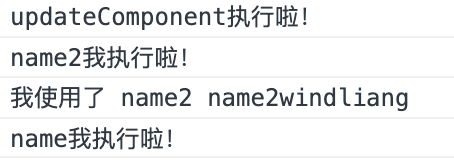
此时我们如果修改 title 的值,updateComponent 函数会重新执行,但因为 name 和 name2 依赖的属性值并没有发生变化,所以他们相应的函数就不会执行了。
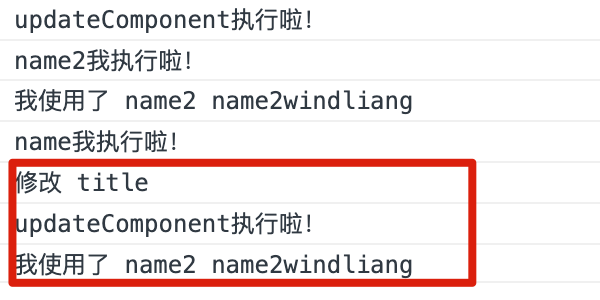
# computed 属性的响应式
思考下边的场景:
import { observe } from "./reactive";
import { initComputed } from "./state";
import Watcher from "./watcher";
const options = {
data: {
firstName: "wind",
secondName: "liang",
title: "标题",
},
computed: {
name() {
console.log("name我执行啦!");
return this.firstName + this.secondName;
},
},
};
observe(options.data);
initComputed(options.data, options.computed);
const updateComponent = () => {
console.log("updateComponent执行啦!");
document.getElementById("root").innerText =
options.data.name + options.data.title;
};
new Watcher(options.data, updateComponent);
setTimeout(() => {
options.data.firstName = "wind2";
}, 1000); // 为什么用 setTimeout 参考 https://vue.windliang.wang/posts/Vue2%E5%89%A5%E4%B8%9D%E6%8A%BD%E8%8C%A7-%E5%93%8D%E5%BA%94%E5%BC%8F%E7%B3%BB%E7%BB%9F%E4%B9%8BnextTick.html
当我们修改了 firstName 的值,毫无疑问,name 和 name2 的值肯定也会变化,使用了 name 和 name2 的函数 updateComponent 此时也应该执行。
但事实上只在第一次的时候执行了,并没有二次触发。

让我们看一下当前的收集依赖图:
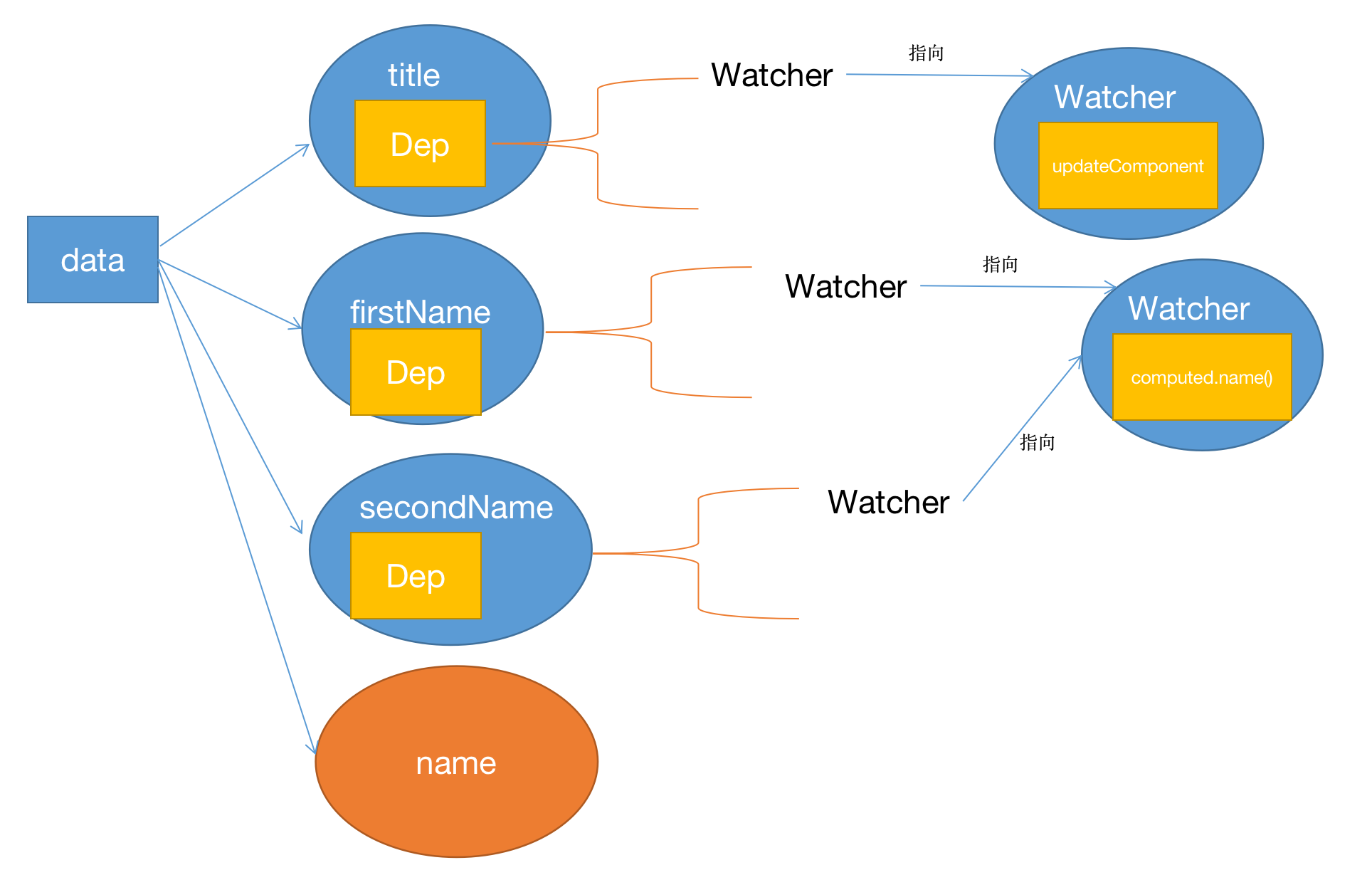
title 属性收集了包含 updateComponent 函数的 Watcher ,firstName 和 secondName 属性都收集了包含 computed.name() 函数的 Watcher。
name 属性是我们后边定义的,没有 Dep 类,什么都没有收集。
我们现在想要实现改变 firstName 或者 secondName 值的时候,触发 updateComponent 函数的执行。
我们只需要读取 name 的时候,让 firstName 和 secondName 收集一下当前的 Watcher ,因为读取 name 的值是在 updateComponent 中执行的,所以当前 Watcher 就是包含了 updateComponent 函数的 Watcher 。
怎么让 firstName 和 secondName 收集当前的 Watcher 呢?
在 name 的 get 中,我们能拿到 computed.name() 对应的 Watcher ,而在 Watcher 实例中,我们把它所有的依赖都保存起来了,也就是这里的 firstName 和 secondName ,如下图:
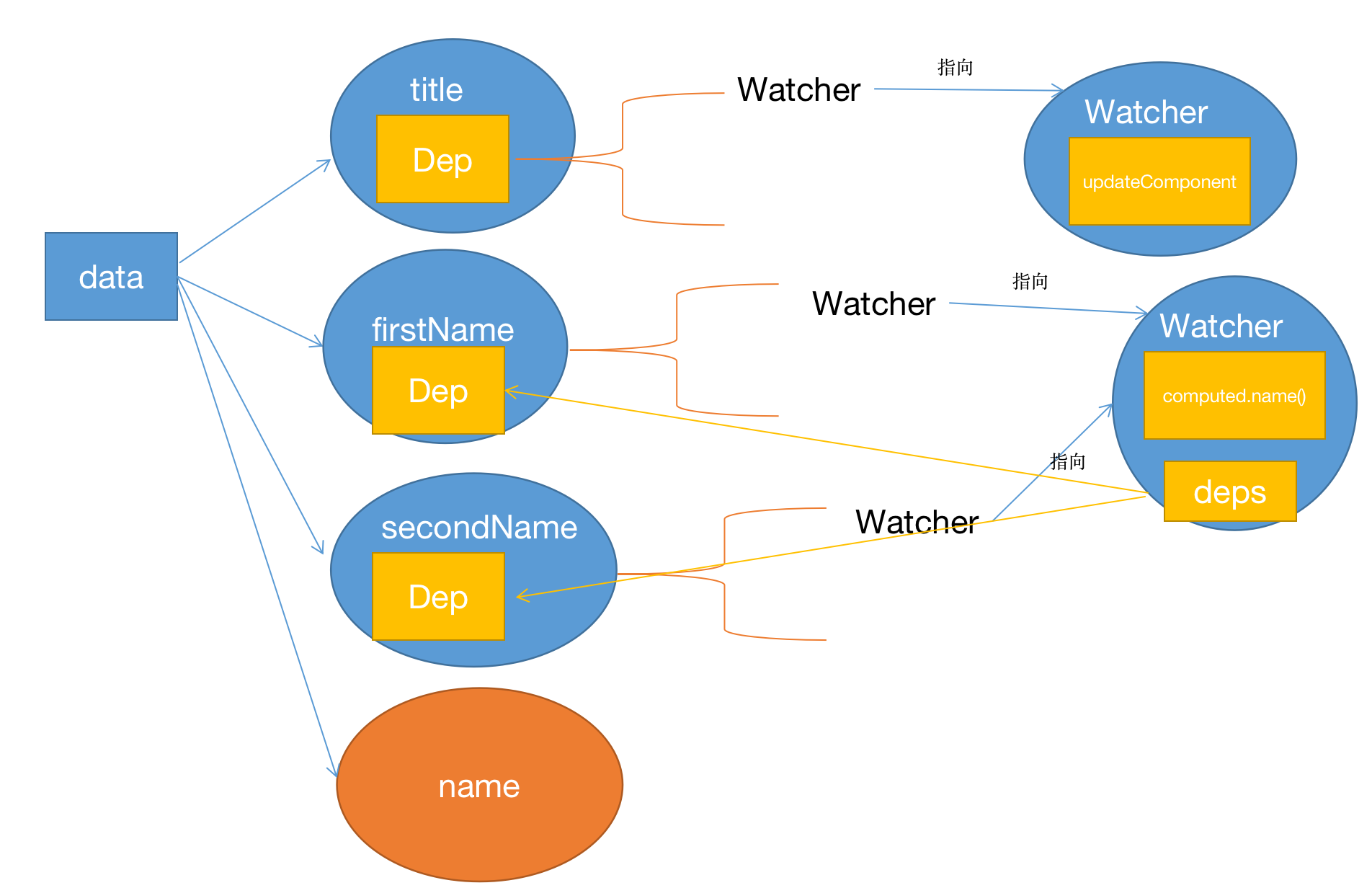
所以我们只需在 Watcher 中提供一个 depend 方法, 遍历所有的依赖收集当前 Watcher 。
export default class Watcher {
constructor(data, expOrFn, cb, options) {
this.data = data;
if (typeof expOrFn === "function") {
this.getter = expOrFn;
} else {
this.getter = parsePath(expOrFn);
}
this.depIds = new Set(); // 拥有 has 函数可以判断是否存在某个 id
this.deps = [];
this.newDeps = []; // 记录新一次的依赖
this.newDepIds = new Set();
...
this.dirty = this.lazy;
this.value = this.lazy ? undefined : this.get();
}
/**
* Add a dependency to this directive.
*/
addDep(dep) {
const id = dep.id;
// 新的依赖已经存在的话,同样不需要继续保存
if (!this.newDepIds.has(id)) {
this.newDepIds.add(id);
this.newDeps.push(dep);
if (!this.depIds.has(id)) {
dep.addSub(this);
}
}
}
/**
* Evaluate the value of the watcher.
* This only gets called for lazy watchers.
*/
evaluate() {
this.value = this.get();
this.dirty = false;
}
/******新增 *************************/
/**
* Depend on all deps collected by this watcher.
*/
depend() {
let i = this.deps.length;
while (i--) {
this.deps[i].depend();
}
}
/************************************/
}
然后在之前定义的计算属性的 get 中触发收集依赖即可。
function createComputedGetter(key) {
return function computedGetter() {
const watcher = this._computedWatchers && this._computedWatchers[key];
if (watcher) {
if (watcher.dirty) {
watcher.evaluate();
}
if (Dep.target) {
watcher.depend();
}
return watcher.value;
}
};
}
回到开头的场景:
import { observe } from "./reactive";
import { initComputed } from "./state";
import Watcher from "./watcher";
const options = {
data: {
firstName: "wind",
secondName: "liang",
title: "标题",
},
computed: {
name() {
console.log("name我执行啦!");
return this.firstName + this.secondName;
},
},
};
observe(options.data);
initComputed(options.data, options.computed);
const updateComponent = () => {
console.log("updateComponent执行啦!");
document.getElementById("root").innerText =
options.data.name + options.data.title;
};
new Watcher(options.data, updateComponent);
setTimeout(() => {
options.data.firstName = "wind2";
}, 1000);
此时修改 firstName 的值就会触发 updateComponent 函数的执行了。
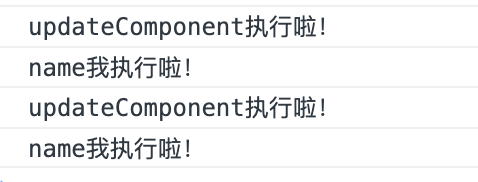
此时的依赖图如下:
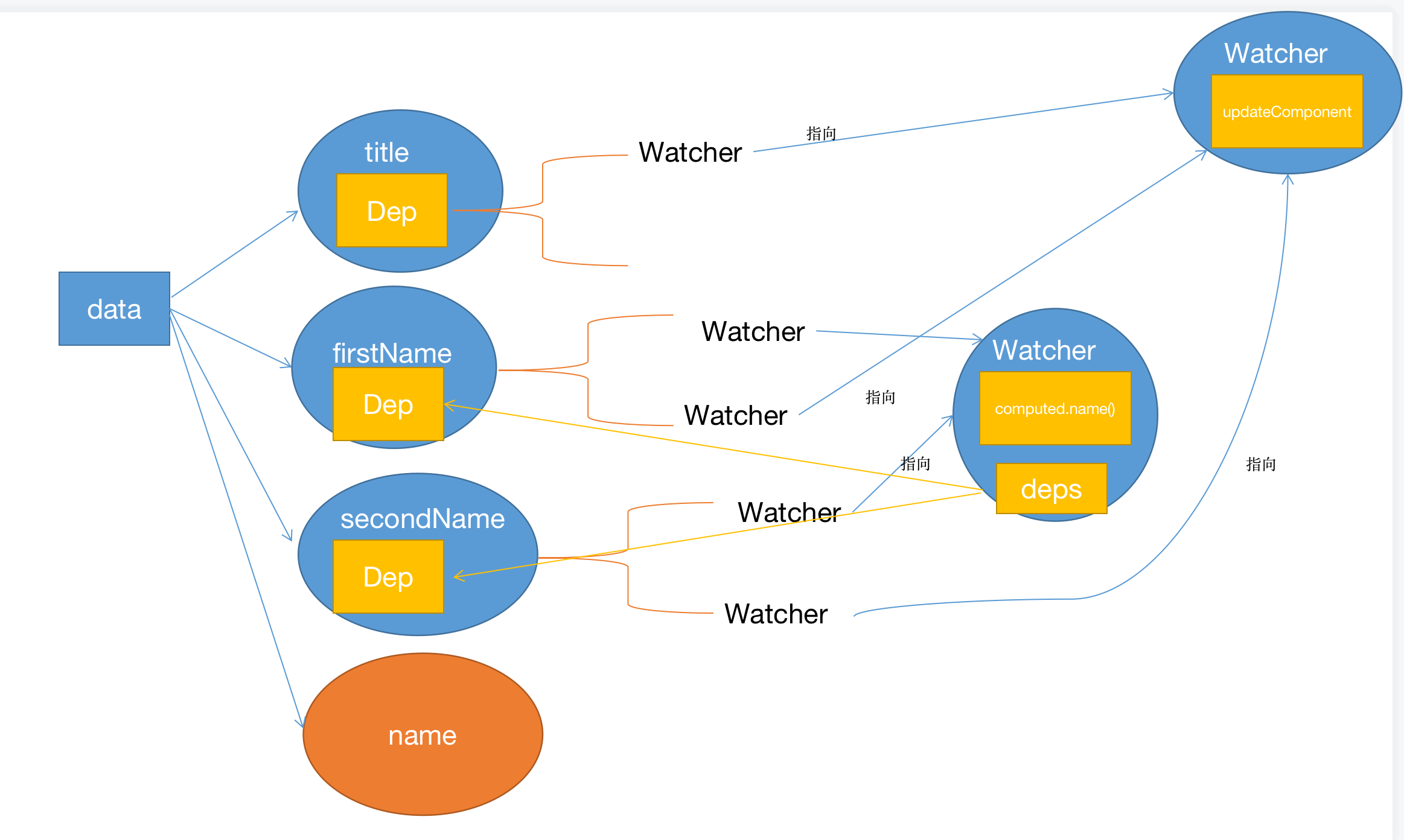
# 总
computed 对应的函数作为了一个 Watcher ,使用计算属性的函数也是一个 Watcher ,computed 函数中使用的属性会将这两个 Watcher 都收集上。
此外 Watcher 增加了 lazy 属性,如果 lazy 为 true,当触发 Watcher 执行的时候不执行内部的函数,将函数的执行让渡给外部管理。
需要注意的一点是,我们是将 computed 所有的 watcher 都挂在了 data 上,实际上 Vue 中是挂在当前的组件实例上的。